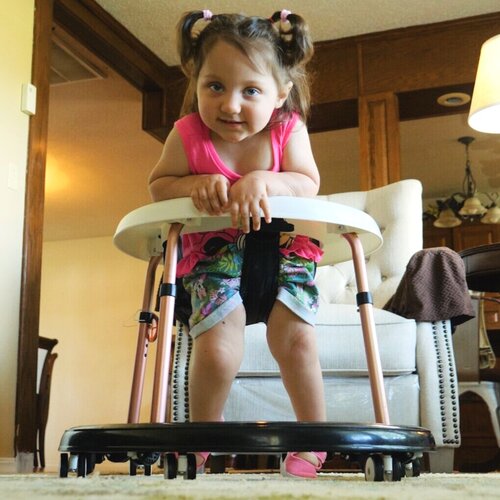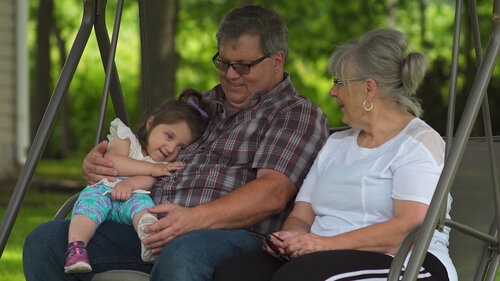(Video updated Sept 2022)


(July 2020) Regann Moore is a little girl who’s full of life. “Happy. Very happy little girl. She always wants to be on the go,” says her father Ferrell Moore. “She likes to be on the four wheeler with her dad. Anything that has wheels on it, she’s ready to roll,” says Diana Moore, Regann’s grandmother. “She definitely gets a lot of loving and she’s a daddy’s girl.”
Her Daddy just smiles and shakes his head when asked about his daughter’s special treatment. “Big time. She’s got me really wrapped around her finger. I will spoil that little girl. She’s earned it.”
Watching this vibrant 2-and-a-half year old, it comes as a bit of a surprise to learn that little Regann survived preparatory therapy and an adult stem cell transplant, all before she was one month old. She was diagnosed with Krabbe Disease just a few days after her birth January 21, 2018, and spent the first three months of her life in a hospital bed with tubes running into her nose, arms and chest.
Krabbe Disease is an inherited disorder that destroys the protective coating (myelin) of nerve cells in the brain and throughout the nervous system. The disease usually results in death by age 2.
“We thought she was a normal little baby girl,” says Ferrell. “The first day I learned Regann was sick was probably about two days after we took her home. I was at my mom’s and I get a phone call. It was Children’s Hospital in St. Louis.”
“the doctors told Ferrell this is a serious disease and Regann could die if we didn’t get her up there in time”
Diana Moore fights through the tears as she remembers her son telling her that Regann was very sick. “They told Ferrell that this is a serious disease and Regann could die if we didn’t get her up there in time. And of course my son, Ferrell, he lost it.”
Ferrell said, “when they said that she probably wouldn’t get to live very long, that’s when it hit home to me because they said it was going to take her out. That’s when I got down on my hands and knees and said a prayer, said, ‘Why, Lord? I got a beautiful little girl that I’m very proud of’, I just didn’t know what to think.”
But because Regann was born in Missouri, where newborn babies are required to be tested for a wide array of diseases, doctors diagnosed Krabbe Disease early.
Doctors told Ferrell to rush Regann back to the hospital and immediately began running a battery of tests. “Just having all the doctors all gathered in that doctor’s office at one time, it put the fear in us how serious Regann’s disease is and what it can do to her,” says Diana.
According to the medical team, the only way to save Regann was with an adult stem cell transplant. Because Krabbe is a genetic disease, they needed to find a donor that matched Regann. They immediately began the search for an umbilical cord blood donor. By catching the disease early, and working quickly, they were able to find a near perfect match
The little girl who’s beating big odds
(Original story from December 2021)
She’s “growing like a weed,” declares her daddy. Adult Stem Cell Recipient Regann Moore continues to amaze everyone with her progress.
Born in January of 2018, Regann was diagnosed with Krabbe Disease, an inherited disorder that destroys the protective coating (myelin) of nerve cells in the brain and throughout the nervous system. For most children, the disease will develop before they are 6 months old and usually result in death by the age of 2.
For Regann however, umbilical cord stem cells have given her victory. Now, at almost 4 years old, Regann attends school, is starting to talk and walk, and loves hippotherapy (therapeutic horseback riding).
Her father, Ferrell, couldn’t be happier or more proud. He knows there are misconceptions about stem cell transplants, but reminds anyone who is leary, “Do the stem cells and you’ll be soul mates.”
Link to Related Articles
Developmental outcomes of cord blood transplantation for Krabbe disease: A 15-year study

After first receiving therapy to prepare her body for the transplant, the life-giving adult stem cells were injected into Regann’s tiny body. “Regann had a lot of IVs and tubes and everything in her little chest and body. It was hard to look at, not knowing if she’s going to make it or not, you know, it would tear you up,” said Diana. “If it wasn’t for Regann getting her umbilical cord stem cell transplant, well actually she wouldn’t have made it. Oh, praise the Lord.”
The transplant was a success. And now at 2-and-a-half years old, Regann is already beating the odds. Developmentally, she’s behind other children of her age, but her dad beams with pride as he talks about her progress. “Regann seems to amaze the doctors at Children’s Hospital every time she goes back for a checkup. They are so impressed on how far she has come because of certain outcomes.”
“Motor skills for her are pretty good. She can reach out and grab toys and dolls and utensils. She’s real strong in her arms. And what she does with the iPad, it amazes us. She has figured all that stuff out herself.”
